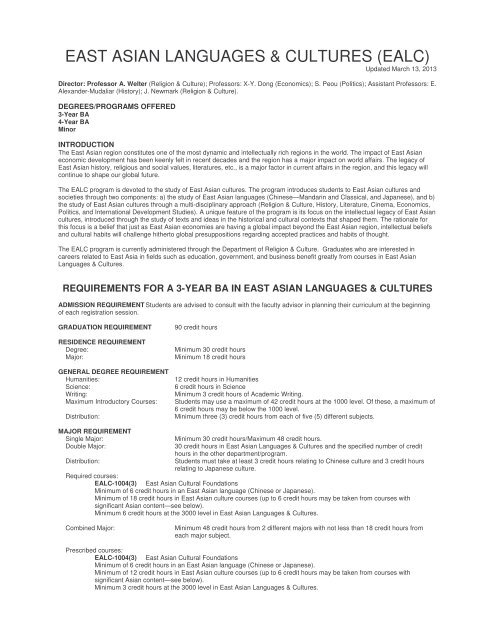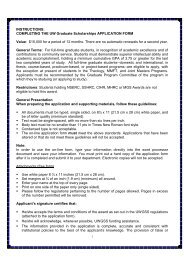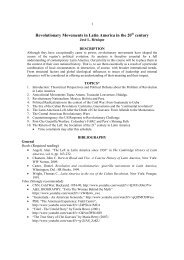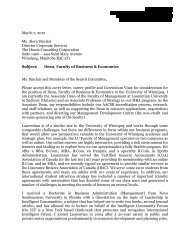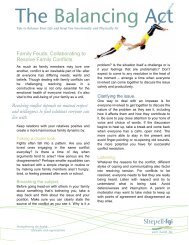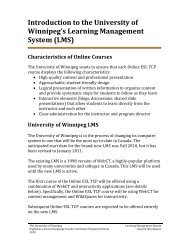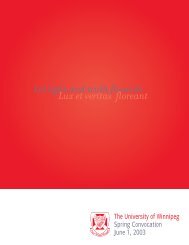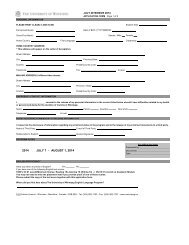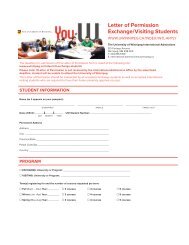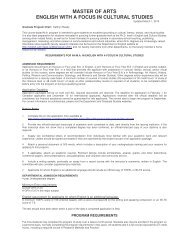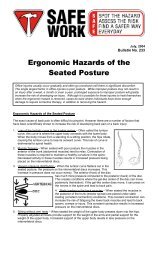EAST ASIAN LANGUAGES & CULTURES (EALC)
EAST ASIAN LANGUAGES & CULTURES (EALC)
EAST ASIAN LANGUAGES & CULTURES (EALC)
Create successful ePaper yourself
Turn your PDF publications into a flip-book with our unique Google optimized e-Paper software.
<strong>EAST</strong> <strong>ASIAN</strong> <strong>LANGUAGES</strong> & <strong>CULTURES</strong> (<strong>EALC</strong>)<br />
Updated March 13, 2013<br />
Director: Professor A. Welter (Religion & Culture); Professors: X-Y. Dong (Economics); S. Peou (Politics); Assistant Professors: E.<br />
Alexander-Mudaliar (History); J. Newmark (Religion & Culture).<br />
DEGREES/PROGRAMS OFFERED<br />
3-Year BA<br />
4-Year BA<br />
Minor<br />
INTRODUCTION<br />
The East Asian region constitutes one of the most dynamic and intellectually rich regions in the world. The impact of East Asian<br />
economic development has been keenly felt in recent decades and the region has a major impact on world affairs. The legacy of<br />
East Asian history, religious and social values, literatures, etc., is a major factor in current affairs in the region, and this legacy will<br />
continue to shape our global future.<br />
The <strong>EALC</strong> program is devoted to the study of East Asian cultures. The program introduces students to East Asian cultures and<br />
societies through two components: a) the study of East Asian languages (Chinese—Mandarin and Classical, and Japanese), and b)<br />
the study of East Asian cultures through a multi-disciplinary approach (Religion & Culture, History, Literature, Cinema, Economics,<br />
Politics, and International Development Studies). A unique feature of the program is its focus on the intellectual legacy of East Asian<br />
cultures, introduced through the study of texts and ideas in the historical and cultural contexts that shaped them. The rationale for<br />
this focus is a belief that just as East Asian economies are having a global impact beyond the East Asian region, intellectual beliefs<br />
and cultural habits will challenge hitherto global presuppositions regarding accepted practices and habits of thought.<br />
The <strong>EALC</strong> program is currently administered through the Department of Religion & Culture. Graduates who are interested in<br />
careers related to East Asia in fields such as education, government, and business benefit greatly from courses in East Asian<br />
Languages & Cultures.<br />
REQUIREMENTS FOR A 3-YEAR BA IN <strong>EAST</strong> <strong>ASIAN</strong> <strong>LANGUAGES</strong> & <strong>CULTURES</strong><br />
ADMISSION REQUIREMENT Students are advised to consult with the faculty advisor in planning their curriculum at the beginning<br />
of each registration session.<br />
GRADUATION REQUIREMENT<br />
RESIDENCE REQUIREMENT<br />
Degree:<br />
Major:<br />
GENERAL DEGREE REQUIREMENT<br />
Humanities:<br />
Science:<br />
Writing:<br />
Maximum Introductory Courses:<br />
Distribution:<br />
90 credit hours<br />
Minimum 30 credit hours<br />
Minimum 18 credit hours<br />
12 credit hours in Humanities<br />
6 credit hours in Science<br />
Minimum 3 credit hours of Academic Writing.<br />
Students may use a maximum of 42 credit hours at the 1000 level. Of these, a maximum of<br />
6 credit hours may be below the 1000 level.<br />
Minimum three (3) credit hours from each of five (5) different subjects.<br />
MAJOR REQUIREMENT<br />
Single Major:<br />
Double Major:<br />
Distribution:<br />
Required courses:<br />
<strong>EALC</strong>-1004(3)<br />
Minimum 30 credit hours/Maximum 48 credit hours.<br />
30 credit hours in East Asian Languages & Cultures and the specified number of credit<br />
hours in the other department/program.<br />
Students must take at least 3 credit hours relating to Chinese culture and 3 credit hours<br />
relating to Japanese culture.<br />
East Asian Cultural Foundations<br />
Minimum of 6 credit hours in an East Asian language (Chinese or Japanese).<br />
Minimum of 18 credit hours in East Asian culture courses (up to 6 credit hours may be taken from courses with<br />
significant Asian content—see below).<br />
Minimum 6 credit hours at the 3000 level in East Asian Languages & Cultures.<br />
Combined Major:<br />
Minimum 48 credit hours from 2 different majors with not less than 18 credit hours from<br />
each major subject.<br />
Prescribed courses:<br />
<strong>EALC</strong>-1004(3) East Asian Cultural Foundations<br />
Minimum of 6 credit hours in an East Asian language (Chinese or Japanese).<br />
Minimum of 12 credit hours in East Asian culture courses (up to 6 credit hours may be taken from courses with<br />
significant Asian content—see below).<br />
Minimum 3 credit hours at the 3000 level in East Asian Languages & Cultures.
REQUIREMENTS FOR A 4-YEAR BA IN <strong>EAST</strong> <strong>ASIAN</strong> <strong>LANGUAGES</strong> & <strong>CULTURES</strong><br />
ADMISSION REQUIREMENT<br />
GRADUATION REQUIREMENT<br />
RESIDENCE REQUIREMENT<br />
Degree:<br />
Major:<br />
GENERAL DEGREE REQUIREMENT<br />
Humanities:<br />
Science:<br />
Social Science:<br />
Writing:<br />
Maximum Introductory Courses:<br />
Distribution:<br />
Students must consult with the department advisor in planning their studies.<br />
Students must have completed at least 30 credit hours previously.<br />
120 credit hours<br />
Minimum 60 credit hours<br />
Minimum 30 credit hours<br />
12 credit hours in Humanities<br />
6 credit hours in Science<br />
12 credit hours in Social Science<br />
Minimum 3 credit hours of Academic Writing.<br />
Students may use a maximum of 42 credit hours at the 1000 level.<br />
Of these, a maximum of 6 credit hours may be below the 1000 level.<br />
Minimum three (3) credit hours from each of five (5) different subjects.<br />
MAJOR REQUIREMENT<br />
Single Major:<br />
Double Major:<br />
Cognates:<br />
Distribution:<br />
Required courses:<br />
<strong>EALC</strong>-1004(3)<br />
Minimum 48 credit hours/Maximum 66 credit hours.<br />
Minimum 48 credit hours in each Major subject as specified by the department/program.<br />
Minimum of 18 credit hours/Maximum of 36 credit hours in related courses from one or<br />
more of several departments.<br />
Maximum total of cognate and major courses is 84 credit hours combined.<br />
Students must take at least 6 credit hours relating to Chinese culture and 6 credit hours<br />
relating to Japanese culture.<br />
East Asian Cultural Foundations<br />
Minimum of 12 credit hours in an East Asian language (Chinese or Japanese).<br />
Minimum of 30 credit hours in East Asian culture courses (up to 12 credit hours may be taken from courses with<br />
significant Asian content—see below).<br />
Minimum of 18 credit hours at the 3000 level in East Asian Languages & Cultures.<br />
Combined Major:<br />
Minimum 60 credit hours from two (2) different majors with not less than 24 credit hours<br />
from each major subject.<br />
Prescribed courses:<br />
<strong>EALC</strong>-1004(3) East Asian Cultural Foundations<br />
Minimum of 12 credit hours in an East Asian language (Chinese or Japanese).<br />
Minimum of 18 credit hours in East Asian culture courses (up to 6 credit hours may be taken from courses with<br />
significant Asian content—see below).<br />
Minimum of 18 credit hours at the 3000 level in East Asian Languages & Cultures.<br />
Study Abroad requirement:<br />
Minimum one semester in an approved study abroad program in an East Asian country. Credits earned while studying<br />
abroad are transferable and may be used to fulfil major requirements.<br />
Individuals' programs will be structured to meet student needs and interests.<br />
Students planning to major in East Asian Languages and Cultures must consult with the Program Coordinator after<br />
completing 30 credit hours.<br />
Courses in Other Departments that fulfil the East Asian culture requirement<br />
Students may include the following courses toward their Major.<br />
Economics ECON-3317(3) Asia Pacific Economies (Note: requires pre-requisite)<br />
International Development Studies IDS-2184(3) Asia/Pacific Development Issues (Note:<br />
requires prerequisite)<br />
Politics 3030(3) Comparative Politics in East Asia<br />
POL-3121(3) Asia-Pacific Security<br />
Courses in Other Departments with significant Asian or Cultural Studies content<br />
Students may take up to 6 credit hours (3 year BA) or 12 credit hours (4 year BA) from the following list of courses to fulfil their<br />
“culture” course requirement.<br />
Anthropology ANTH-1002(3) Introduction to Cultural Anthropology,<br />
ANTH-2100(3) Method & Theory in Cultural Anthropology<br />
History HIST-2701(6) Asia Since 1500<br />
HIST-2703(3) South Asia Since 1500<br />
HIST-3706(6) Colonialism & Nationalism in India<br />
HIST-3708(3) Women’s History in South Asia
HIST 3118(3) South Asian Diaspora Since 1800<br />
HIST 4703(6) Postcolonial India (requires permission)<br />
Religion & Culture REL-1002(6) Exploring Religion: the World’s Religions<br />
REL-2704(3) Buddhist Traditions in India & Southeast Asia<br />
REL-2901(3) Art in Non-Christian Religions<br />
Sample Program (3 year)<br />
Years 1-2: East Asian Cultural Foundations (<strong>EALC</strong> 1004)<br />
3 credit hours<br />
Intro. Language course (<strong>EALC</strong> 1100 or 1200)<br />
6 credit hours<br />
East Asian Culture courses (2000 level)<br />
6 credit hours<br />
Year 3: Intermediate Language course (<strong>EALC</strong> 2100 or 2200) 6 credit hours<br />
East Asian Culture courses (2000 level)<br />
3 credit hours<br />
East Asian Culture course (3000 level)<br />
6 credit hours<br />
Sample Program (4 year)<br />
Years 1-2: East Asian Cultural Foundations (<strong>EALC</strong> 1004)<br />
3 credit hours<br />
Intro. Language course (<strong>EALC</strong> 1100 or 1200)<br />
6 credit hours<br />
East Asian Culture courses (2000 level)<br />
6 credit hours<br />
Year 3: Intermediate Language course (<strong>EALC</strong> 2100 or 2200) 6 credit hours<br />
East Asian Culture courses (2000 level)<br />
6 credit hours<br />
East Asian Culture courses (3000 level)<br />
3 credit hours<br />
Year 4: Semester abroad Language & Culture courses<br />
East Asian Culture courses (2000 level)<br />
3 credit hours<br />
East Asian Culture courses (3000 level)<br />
15 credit hours<br />
REQUIREMENTS FOR A MINOR IN <strong>EAST</strong> <strong>ASIAN</strong> <strong>LANGUAGES</strong> & <strong>CULTURES</strong><br />
Degree:<br />
Students must complete a 4-year degree program in order to be eligible to hold the Minor.<br />
Minor:<br />
18 credit hours in the Minor subject, with a minimum of 12 credit hours above the 1000-level<br />
Residence Requirement: Minimum 12 credit hours in the Minor subject<br />
Required courses:<br />
Minimum 6 credit hours of East Asian language courses<br />
Minimum 3 credit hours at 3000 or 4000 level<br />
Restrictions:<br />
Students cannot declare the same subject as a Major and a Minor.<br />
COURSE LISTINGS<br />
INTRODUCTORY COURSES<br />
Majors are required to take <strong>EALC</strong>-1004, East Asian Cultural foundations and either <strong>EALC</strong>-1100 (Introduction to Japanese<br />
Language) or <strong>EALC</strong>-1200 (Introduction to Chinese Language).<br />
AREAS OF STUDY<br />
Note: Courses are offered on rotation.<br />
Note: 2000-level courses are open to all students, without prerequisite.<br />
Note: Except where otherwise indicated the 3000-level courses are open to students who have completed successfully at least 6<br />
credit hours in East Asian Languages & Cultures, or who have received the consent of the instructor.<br />
East Asian Languages courses<br />
(courses that fulfill East Asian language requirements)<br />
<strong>EALC</strong>-1100(6) Introduction to Japanese Language<br />
<strong>EALC</strong>-1200(6) Introduction to Chinese Language<br />
<strong>EALC</strong>-1202(6) Introduction to Chinese for Heritage Students<br />
<strong>EALC</strong>-1300(6) Introduction to Korean Language<br />
<strong>EALC</strong>-2100(6) Intermediate Japanese Language<br />
<strong>EALC</strong>-2200(6) Intermediate Chinese Language<br />
<strong>EALC</strong>-2031(6) Chinese-English Translation<br />
<strong>EALC</strong>-2300(6) Intermediate Korean Language<br />
<strong>EALC</strong>-3007(6) Introduction to Classical Chinese<br />
<strong>EALC</strong>-3100(6) Advanced Japanese<br />
East Asian Cultures courses<br />
(courses that fulfill East Asian cultures requirements; see also Courses in Other Departments that fulfil the East Asian culture<br />
requirement and Courses in Other Departments with significant Asian or Cultural Studies content, listed above)<br />
<strong>EALC</strong>-1004(3) East Asian Cultural Foundations<br />
HIST-2704(3) History of East Asia Since 1500<br />
<strong>EALC</strong>-2707(3) Chinese Religions<br />
<strong>EALC</strong>-2708(3) Religion in Japanese Life<br />
<strong>EALC</strong>-2709(3) Women in Asian Religions & Cultures<br />
<strong>EALC</strong>-2718(3) Buddhist Traditions in East Asia<br />
<strong>EALC</strong>-2721(3) Traditional Japanese Culture<br />
<strong>EALC</strong>-2723(3) Japanese Cinema<br />
<strong>EALC</strong>-2731(3) Chinese Culture & Beliefs
<strong>EALC</strong>-2734(3) The Making of Modern East Asian Culture<br />
<strong>EALC</strong>-2772(3) Modern Chinese Literature in Translation<br />
<strong>EALC</strong>-2773(3) Chinese Cinema<br />
<strong>EALC</strong>-2774(3) Chinese Intellectual History<br />
<strong>EALC</strong>-2775(3) Intellectual Encounters: China and the West<br />
<strong>EALC</strong>-3704(3) / 4704(3) Chinese & East Asian Perspectives on Human Rights<br />
<strong>EALC</strong>-3707(3) / 4707(3) Zen Buddhism & East Asian Culture<br />
<strong>EALC</strong>-3708(3) / 4708(3) Topics in Buddhist Culture & Society<br />
<strong>EALC</strong>-3720(3) / 4720(3) Topics in Japanese Culture & Society<br />
<strong>EALC</strong>-3721(3) / 4721(3) The Age of the Samurai<br />
<strong>EALC</strong>-3731(3) / 4731(3) Topics in Chinese Culture & Society<br />
<strong>EALC</strong>-3732(3) / 4732(3) Topics in Chinese Intellectual and Cultural History<br />
<strong>EALC</strong>-3970(3) / 4970(3) Topics in Asian Religions and Cultures<br />
COURSE DESCRIPTIONS<br />
<strong>EALC</strong> 1004(3) <strong>EAST</strong> <strong>ASIAN</strong> CULTURAL FOUNDATIONS<br />
(Le3) This course introduces students to the cultural<br />
traditions and belief systems of East Asia (primarily China,<br />
Japan, and Korea). Traditions examined include<br />
Confucianism, Daoism (Taoism), and Buddhism. Special<br />
attention is given to the examination of ideas stemming from<br />
primary source documents (in translation) within their<br />
historical and cultural contexts. Emphasis is given to the<br />
central role played by developments in China for the<br />
formation of East Asian cultural values.<br />
<strong>EALC</strong>-1100(6) INTRODUCTION TO JAPANESE<br />
LANGUAGE (Le3/La1) This course introduces students to<br />
the modern Japanese language. The aim of this course is to<br />
provide a solid base in vocabulary, grammar, and<br />
pronunciation through speaking, listening, writing, and<br />
reading exercises. Students are introduced to Japanese<br />
syllabary (hiragana and katakana) and basic Japanese<br />
characters (kanji). In addition to providing the basis for<br />
further research for <strong>EALC</strong> students interested in Japanese<br />
studies, the course is of interest to a variety of students from<br />
various disciplines interested in acquiring basic Japanese<br />
language skills.<br />
RESTRICTIONS: Native speakers of Japanese or students<br />
who have standing in Japanese 40S or equivalent are not<br />
eligible to take this course. Students may not receive credit<br />
for both this course and the former REL-2020(6).<br />
<strong>EALC</strong>-1200(6) INTRODUCTION TO CHINESE LANGUAGE<br />
(Le3/La1) This course introduces students to the modern<br />
standard Chinese language (Mandarin). The aim of the<br />
course is to provide a solid base in vocabulary, grammar,<br />
and pronunciation through speaking, listening, writing and<br />
reading exercises. In addition to providing the basis for<br />
further research for <strong>EALC</strong> students interested in Chinese<br />
studies, the course is of interest to a variety of students from<br />
various disciplines interested in acquiring basic Chinese<br />
language skills.<br />
RESTRICTIONS: Permission of Instructor required. This course<br />
is not intended for Chinese native speakers, including<br />
speakers of dialects other than Mandarin. Students may not<br />
receive credit for both this course and the former REL-<br />
2030(6).<br />
<strong>EALC</strong>-1202(6) INTRODUCTION TO CHINESE FOR<br />
HERITAGE STUDENTS (Le3/La1) This course is designed<br />
as part of the <strong>EALC</strong> Chinese language program. It is an<br />
introductory course for heritage language learners who<br />
have speaking ability in Mandarin Chinese or Chinese<br />
dialects, but have little or no knowledge of written Chinese.<br />
Building upon students’ oral abilities, this course aims to<br />
develop students’ communicative competence in listening,<br />
speaking, reading and writing in spoken and written<br />
Mandarin (simplified characters), with special emphasis on<br />
reading and writing. Students in this course learn<br />
pronunciation (Pinyin system), the Chinese writing system, basic<br />
vocabulary, grammatical structures, and written characters.<br />
Chinese culture is integrated throughout the language learning<br />
process. The key terms relating to Chinese religions and culture<br />
are also studied.<br />
<strong>EALC</strong>-1300(6) INTRODUCTION TO KOREAN LANGUAGE<br />
(Le3/La1) This course introduces students to the modern Korean<br />
language. The aim of this course is to provide a solid base in<br />
vocabulary, grammar, and pronounciation through speaking,<br />
listening, writing and reading exercises. Students are introduced<br />
to the Korean characters known as Hangul. In addition to<br />
providing the basis for further research for Religious Studies<br />
students interested in Asian religions, the course is of interest to a<br />
variety of students from various desciplines interested in acquiring<br />
basic Korean language skills.<br />
Prerequisite: Permission of the instructor<br />
Restriction: Native speakers of Korean or students who have<br />
standing in Korean 40S or the former REL-2040(6) or equivalent<br />
are not eligible to take this course.<br />
<strong>EALC</strong>-2031(6) CHINESE-ENGLISH TRANSLATION (Le3) This<br />
course seeks to improve students’ language skills and deepen<br />
their ability to communicate meanings in written texts between the<br />
two languages and two cultures. Students translate original<br />
scripts drawn from various genres of literature, including scientific<br />
materials and documents. Basic approaches include guided class<br />
discussion, a minimum of lecture time and a maximum of<br />
translation practice time. This course is an introduction to the<br />
principles and techniques of translation, but requires proficiency in<br />
the Chinese and English languages.<br />
Prerequisites: at least 3 credit hours in RHET 1101, RHET1102,<br />
RHET1103, RHET1104,RHET1105, RHET1104.<br />
<strong>EALC</strong>-2100(6) INTERMEDIATE JAPANESE LANGUAGE<br />
(Le3/La1) In this course, students extend their knowledge of<br />
Japanese grammar and vocabulary in communicative and<br />
academic contexts through assignments, group work, and<br />
exercises in speaking, listening, writing, and reading. Students<br />
are expected to be able to read and write hiragana, katakana, and<br />
some kanji, and to have mastered pronunciation and basic<br />
Japanese grammar. In addition to providing the basis for further<br />
research for students in <strong>EALC</strong> who are interest in Japanese<br />
studies, this course is of interest to elementary students of<br />
Japanese who wish to improve their language skills.<br />
PREREQUISITES: <strong>EALC</strong> 1100(6) or equivalent.<br />
RESTRICTIONS: Native Speakers of Japanese are not eligible to<br />
take this course.<br />
<strong>EALC</strong>-2200(6) INTERMEDIATE CHINESE LANGUAGE (Le3,<br />
La1) This course is a continuation of Introduction to Chinese<br />
Language (Mandarin), and is a study of Chinese in its spoken and<br />
written forms with more vocabulary, more advanced grammatical<br />
structures and written characters. Equal emphasis is given to<br />
speaking, listening, reading, and writing. Chinese dictionary<br />
usage is also addressed. In addition to providing the basis for
further research for <strong>EALC</strong> students interested in Chinese<br />
studies, this course is of interest to a variety of students who<br />
wish to improve their Chinese language skills.<br />
PREREQUISITES: This course is open to students who have<br />
taken Introduction to Chinese Language (<strong>EALC</strong> 1200(6) or<br />
equivalent, or whose Chinese language ability meets the<br />
expectation of the introductory course. Students without the<br />
prerequisite must get permission from the instructor.<br />
RESTRICTIONS: Speakers of dialects other than Mandarin<br />
must receive permission from the instructor to take this<br />
course.<br />
<strong>EALC</strong>-2300(6) INTERMEDIATE KOREAN LANGUAGE<br />
(Le3/La1) Intermediate Korean is designed for students who<br />
have already completed Introduction to Korean or the<br />
equivalent. Building on their knowledge of Korean, students<br />
will learn more advanced vocabulary, grammar, and<br />
idiomatic expressions that are used in traditional and modern<br />
Korean. Students will also learn about Korean culture<br />
through the textbook and occasional audio and visual<br />
materials. In class, students are encouraged to speak as<br />
much Korean as possible to improve their oral<br />
communication skills. Overall, the course aims to develop<br />
intermediate-level proficiency in reading, writing, speaking,<br />
and listening skills.<br />
Prerequisites: <strong>EALC</strong>-1300 or equivalent.<br />
<strong>EALC</strong>-2707(3) CHINESE RELIGIONS (Le3) This course is a<br />
study of the basic beliefs and practices of the Chinese as<br />
informed by the three major Chinese traditions: Confucian,<br />
Daoist (Taoist), and Buddhist. The course will examine the<br />
development of each of these traditions, as well as their<br />
blending into a comprehensive set of beliefs and practices<br />
that shaped the common understanding and practice of<br />
Chinese religion. The effect of Communism on Chinese<br />
religious life and the resurgence of religion in contemporary<br />
China will also be examined.<br />
CROSS LISTED: Religion & Culture REL-2707(3)<br />
<strong>EALC</strong>-2708(3) RELIGION IN JAPANESE LIFE (Le3) This<br />
course examines the religious life of the Japanese people,<br />
as informed by traditions deriving from the native Shinto<br />
religion of Japan, the adapted traditions of Buddhism and<br />
Confucianism, and the impact of Westernization and<br />
modernization on traditional beliefs and practices.<br />
CROSS LISTED: Religion & Culture REL-2708(3)<br />
<strong>EALC</strong>-2709(3) WOMEN IN <strong>ASIAN</strong> RELIGIONS &<br />
<strong>CULTURES</strong> (Le3) The course examines the experiences of<br />
women in several Asian cultures (e.g., Indian, Chinese,<br />
Japanese), and in several religious traditions (e.g.,<br />
Hinduism, Buddhism, Confucianism, Daoism). The course is<br />
intended as a comprehensive introduction to women’s<br />
experience in both pre-modern and modern contexts, with<br />
attention to how women are perceived and perceive<br />
themselves in religious and cultural roles.<br />
CROSS LISTED: Religion & Culture REL-2709(3)<br />
<strong>EALC</strong>-2718(3) BUDDHIST TRADITIONS IN <strong>EAST</strong> ASIA<br />
(Le3) This course traces the historical development of<br />
Mahayana (Great Vehicle) Buddhism in East Asia, focusing<br />
on the founding of East Asian Buddhist traditions in China,<br />
and their transmission to Korea and Japan. The course<br />
introduces the major beliefs and practices associated with<br />
East Asian Buddhism, the schools, figures, and texts that<br />
form the traditions that have flourished in East Asian<br />
countries. In addition to Chinese Buddhist developments, the<br />
course examines the adaptation of Chinese Buddhist<br />
traditions in Korea and Japan.<br />
CROSS LISTED: Religion & Culture REL-2718(3)<br />
<strong>EALC</strong>-2721(3) TRADITIONAL JAPANESE CULTURE (Le3)<br />
This course surveys traditional Japanese culture through an<br />
exploration of visual and dramatic arts, literature, philosophy, and<br />
religion. Special emphasis is placed on cross-cultural roots that<br />
bridged Japan with its neighboring countries in East Asia. The<br />
historical foundations of popular Japanese contemporary<br />
culture—Manga, Anime, and high technology to name a few—are<br />
also discussed.<br />
CROSS LISTED: Religion & Culture REL-2721(3)<br />
<strong>EALC</strong>-2723(3) JAPANESE CINEMA (Le3) This course surveys<br />
Japanese cinema from the 1960s to the present day. To<br />
understand the context of the films, relevant literature (short<br />
stories, novels, and traditional Japanese theater on which the<br />
films are based) is discussed. In the process, the focus is on<br />
transitions from modern to postmodernism, alterity, and<br />
subjectivity in film. Directors examined include, among others,<br />
Ozu, Mishima, Kurosawa, Teshigahara, Miyazaki, and Kitano.<br />
<strong>EALC</strong>-2731(3) CHINESE CULTURE & BELIEFS (Le3) This<br />
course focuses on Chinese traditions and values that have<br />
influenced modern Chinese society. This course is introductory<br />
and requires no prior knowledge of Chinese language and history.<br />
Students in the course discover ways in which cultural<br />
representations in social life, customs, business practice,<br />
literature, and art have affected and are being affected by beliefs.<br />
Through lecture and guided discussion students better<br />
understand how traditions and beliefs continue to inform about<br />
Chinese culture today.<br />
CROSS LISTED: Religion & Culture REL-2731(3)<br />
<strong>EALC</strong>-2734(3) THE MAKING OF MODERN <strong>EAST</strong> <strong>ASIAN</strong><br />
CULTURE (Le3) This course introduces students to East Asian<br />
culture in modern times. It surveys the transformation of<br />
traditional cultural values as a result of intense political and<br />
cultural influence from the West since the late 19 th century, and<br />
explores the roots of contemporary culture in China, Japan, and<br />
Korea. Particular attention is given to the impact of literature<br />
(primarily short stories and novels by early 20 th -century<br />
intellectuals) and Western thought on the East Asian region (e.g.<br />
social Darwinism, liberalism, science and democracy, introduced<br />
to East Asia during the late 19 th century), and on the way in which<br />
traditional values are being critically re-evaluated as China,<br />
Japan, and Korea have endeavoured to modernize their societies.<br />
<strong>EALC</strong>-2772(3) MODERN CHINESE LITERATURE IN<br />
TRANSLATION (Le3) The course focuses on Chinese literary<br />
texts that reflect the stylistic conventions and cultural issues of<br />
China between 1911 and the 21 st century. The course is<br />
introductory and requires no prior knowledge of Chinese<br />
language, history, or culture. All texts in this course are in English.<br />
Students not only examine the forms and contents of the literary<br />
texts from various theoretical points of view, but also explore the<br />
social, political, and historical contexts in which these texts are<br />
written. Through lecture and guided discussion, students<br />
discover the ways in which Modern Chinese Literature continues<br />
to inform about Chinese culture today.<br />
<strong>EALC</strong> 2773(3) CHINESE CINEMA (Le3) This course focuses on<br />
films produced by Chinese filmmakers between the 1930s and the<br />
present in appropriate historical and cultural contexts. The course<br />
is introductory and requires no prior knowledge of Chinese<br />
language, history, culture, or literature. All the films studied in the<br />
course have English subtitles. Students in the course generally<br />
view one film per week, preceded by preparatory lecture and<br />
followed by guided class discussion.<br />
<strong>EALC</strong>-2774(3) CHINESE INTELLECTUAL HISTORY (Le3) This<br />
course explores the intellectual history of China, focusing on<br />
developments before the Qing Dynasty (1644). Leading<br />
intellectual currents of Chinese thought are examined within the<br />
historical contexts that produced them. Special attention is given<br />
to interactions and debates within and between the traditions of<br />
Confucianism, Daoism, and Buddhism.<br />
CROSS LISTED: Religion & Culture REL-2774(3).
<strong>EALC</strong>-2775(3) CHINA & THE WEST (Le3) In this course,<br />
intellectual encounters between China and the West from<br />
the 17th century to the present are examined in order to gain<br />
an understanding of China's search for identity. Topics<br />
include Chinese reactions to and adaptations of Western<br />
ideas, the ongoing validity of native traditions and<br />
institutions, the threat posed by Westernization and<br />
modernization, and the influence that these have had on the<br />
development of modern China.<br />
CROSS LISTED: Religion & Culture REL-2775(3).<br />
<strong>EALC</strong>-3007(6) INTRODUCTION TO CLASSICAL CHINESE<br />
(Le3) This course introduces students to Classical Chinese<br />
language grammar, style, and the use of traditional<br />
characters, through the reading of excerpts from traditional<br />
Chinese literature, the basis from which all forms of the<br />
Classical Chinese writing system, in Japan and Korea as<br />
well as China, developed. Special attention is given to texts<br />
from ancient China’s intellectual and religious traditions,<br />
Confucianism and Daoism (Taoism). The course assumes<br />
no prior knowledge of Chinese.<br />
RESTRICTIONS: Not available to students with prior training in<br />
Classical Chinese. Students may not receive credit for this<br />
and the former REL-2007(6).<br />
CROSS LISTED: Religion & Culture REL-3007(6)<br />
<strong>EALC</strong> 3100 (6) ADVANCED JAPANESE In this course,<br />
students complete their undergraduate studies in the<br />
Japanese language through advanced communicative and<br />
written exercises. Special emphasis is placed on social<br />
science readings, allowing students to read and comprehend<br />
a Japanese language newspaper article by the end of the<br />
course. Students are also encouraged to participate in the<br />
advanced level of the Manitoba Japanese Speech Contest.<br />
Prerequisites: <strong>EALC</strong>-2100(6) or permission of instructor.<br />
<strong>EALC</strong>-3704(3) / <strong>EALC</strong>-4704(3) CHINESE AND <strong>EAST</strong><br />
<strong>ASIAN</strong> PERSPECTIVES ON HUMAN RIGHTS This course<br />
focuses on conceptions of human rights in the Chinese and<br />
East Asian cultural context. While human rights notions are<br />
accepted and appreciated in many parts of Asia, the origins<br />
of human rights are rooted in Western intellectual discourses<br />
centering on notions of the individual and individual<br />
autonomy. Asian traditions are, as a rule, conceived on<br />
communitarian frameworks where individuality is subsumed<br />
within a framework defined by the needs of a community,<br />
however defined. The course explores the diversity of Asian<br />
views on this topic, with a focus on those emanating from<br />
Chinese culture.<br />
PREREQUISITE:: At least one non-language course in <strong>EALC</strong>,<br />
or permission of instructor.<br />
RESTRICTIONS: Students may not receive credit for both <strong>EALC</strong>-<br />
3704(3) and <strong>EALC</strong>-4704(3).<br />
CROSS LISTED: Religion and Culture REL 3704(3) / 4704(3),<br />
Human Rights & Global Studies HRGS 3311(3).<br />
<strong>EALC</strong>-3707(3) / <strong>EALC</strong>-4707(3) ZEN BUDDHISM & <strong>EAST</strong><br />
<strong>ASIAN</strong> CULTURE (S3) This course examines the history of<br />
Zen (Chinese Chan) Buddhism against the background of<br />
East Asian culture and its Buddhist heritage. The course<br />
features an examination of classical Zen texts (in<br />
translation), contrasting traditional interpretations with those<br />
of contemporary scholars.<br />
PREREQUISITES: 6 credit hours in East Asian Cultures<br />
courses (or equivalent), or permission of the instructor.<br />
Students registering at the 4000 level must have<br />
Departmental permission.<br />
RESTRICTIONS: Students may not receive credit for both<br />
<strong>EALC</strong>-3707(3) and <strong>EALC</strong>-4707(3).<br />
CROSS LISTED: Religion & Culture REL-3707(3) / 4707(3)<br />
<strong>EALC</strong>-3708(3) / <strong>EALC</strong>-4708(3) TOPICS IN BUDDHIST<br />
CULTURE & SOCIETY (S3) This course explores topics of<br />
contemporary interest regarding the study of Buddhism and<br />
society, examining major issues facing Buddhism in the Asian<br />
context, focusing on aspects of the institutional, social, and<br />
political role played by Buddhism. May be taken for credit more<br />
than once, with permission of instructor. Topics may include:<br />
Buddhism and Tibetan identity in the struggle for Tibetan<br />
autonomy in China, the Buddhist monastic institution and its role<br />
in society, and debates over the interpretation of Buddhism in<br />
modern Asian countries.<br />
PREREQUISITES: 6 credit hours in East Asian Cultures courses (or<br />
equivalent), or permission of the instructor. Students registering at<br />
the 4000 level must have Departmental permission.<br />
RESTRICTIONS: Students may not receive credit for both <strong>EALC</strong>-<br />
3708(3) and <strong>EALC</strong>-4708(3).<br />
CROSS LISTED: Religion & Culture REL-3708(3) / 4708(3)<br />
<strong>EALC</strong>-3720(3) / <strong>EALC</strong>-4720(3) TOPICS IN JAPANESE<br />
CULTURE & SOCIETY (S3) This course examines a variety of<br />
topics in Japanese Culture and Society. Topics selected change<br />
from year to year according to instructor and student interests.<br />
Possible topics may include the development of intellectual<br />
culture in Tokugawa Japan (1600-1868), the role of women in<br />
Japanese culture, Shinto (“the way of the gods”) thought and<br />
practice, and the search for identity in modern Japan. This course<br />
may be taken for credit more than once, with permission of the<br />
instructor.<br />
PREREQUISITES: 6 credit hours in East Asian Cultures courses (or<br />
equivalent), or permission of the instructor.<br />
<strong>EALC</strong>-3721(3) / <strong>EALC</strong>-4721(3) THE AGE OF THE SAMURAI<br />
(S3) “Samurai” often evokes an image of a warrior entranced in<br />
the Bushido code, ready to commit harakiri upon command. This<br />
course demystifies such an aura surrounding Japan’s warrior<br />
class by exploring their rise from Heian temple servants to<br />
Sengoku warlords and then their fall from Edo Japan’s<br />
intellectuals and bureaucrats to the realms of the destitute.<br />
Sources include samurai autobiographies, their intellectual<br />
scholarship, and representations of samurai in contemporary<br />
popular culture.<br />
Prerequisites: <strong>EALC</strong>/REL-2721 or permission of the instructor.<br />
Cross Listed: Religion and Culture REL-3721(3) / 4721(3).<br />
<strong>EALC</strong>-3731(3) / <strong>EALC</strong>-4731(3) TOPICS IN CHINESE CULTURE<br />
& SOCIETY (S3) This course explores specific topics in the Asian<br />
Religions and Cultures area of study at an advanced level. This<br />
course may be repeated for credit when the topic varies. Students<br />
enrolled at the 4000 level are typically assigned a heavier<br />
workload in terms of assignments and are expected to perform at<br />
a more advanced level. Students should consult the department<br />
regarding potential offerings in a given year.<br />
PREREQUISITES: 6 credit hours in East Asian Cultures courses (or<br />
equivalent), or permission of the instructor.<br />
CROSS LISTED: Religion & Culture REL-3731(3) / 4731(3).<br />
<strong>EALC</strong> 3732(3) / 4732(3) TOPICS IN CHINESE INTELLECTUAL<br />
AND CULTURAL HISTORY (S3) This course explores a variety<br />
of topics in Chinese intellectual history. It examines specific<br />
cultural, literary, and intellectual trends in China, paying specific<br />
attention to how they were shaped by a variety of social, political,<br />
economic, and religious factors. Possible topics may include<br />
correlative cosmology in Han Confucianism, individualism in<br />
medieval China, Tang-Song intellectual transitions, Buddhist-<br />
Confucian interactions in the Middle Period of China, Neo-<br />
Confucianism and its social impacts in Late-Imperial China, the<br />
rise of evidential studies in Qing China, and the May Fourth<br />
Movement. This course may be repeated for credit when the topic<br />
varies. Additional work is required at the 4000 level<br />
PREREQUISITES: 6 credit hours in East Asian Cultures courses (or<br />
equivalent), or permission of the instructor.
REL-3970(3) / 4970(3) TOPICS IN <strong>ASIAN</strong> RELIGIONS AND<br />
<strong>CULTURES</strong> (S3) This course explores specific topics in the<br />
Asian Religions and Cultures area of study at an advanced<br />
level. This course may be repeated for credit when the topic<br />
varies. Students enrolled at the 4000 level are typically<br />
assigned a heavier workload in terms of assignments and<br />
are expected to perform at a more advanced level. Students<br />
should consult the department regarding potential offerings<br />
in a given year.<br />
PREREQUISITES: 6 credit hours in East Asian Languages and<br />
Cultures or 6 credit hours in Religion & Culture, 3 of which<br />
must be in the Asian Religions and Cultures area of study, or<br />
permission of the instructor. Students registering at the 4000<br />
level must have departmental permission.<br />
CROSS LISTED: Religion and Culture REL 3970(3) / 4970(3).<br />
<strong>EALC</strong>-4700(3) TOPICS IN <strong>ASIAN</strong> RELIGIONS AND<br />
<strong>CULTURES</strong> (S3) This course studies specific topics in Asian<br />
Religions and Cultures at an advanced level. Students<br />
should consult the department regarding potential offerings<br />
in a given year.<br />
PREREQUISITES: Permission of Department Chair.<br />
CROSS LISTED: Religion & Culture REL-4700(3)


